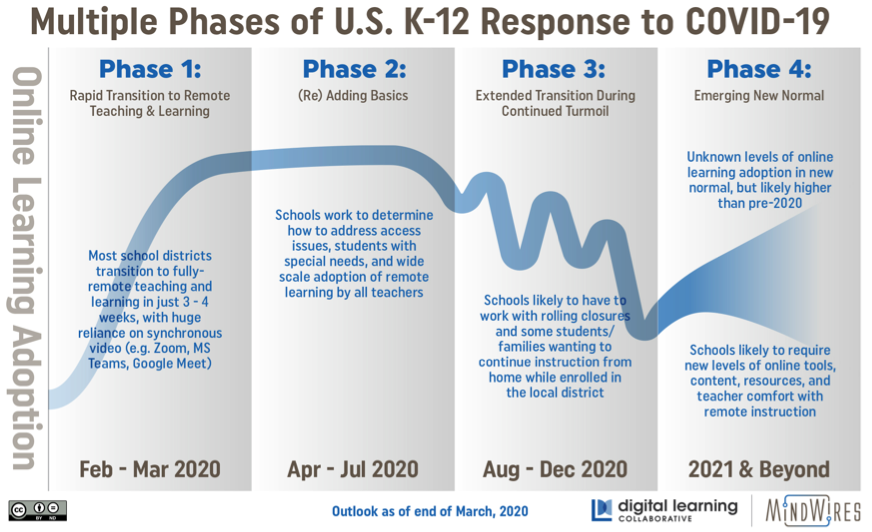What will the rest of the school year look like?
With COVID-19 cases spiking in almost all states, many districts pulling back on instruction in physical schools, and promising vaccine news emerging, this seems like a good time to gaze into the virtual crystal ball and think about what the coming months will mean to our schools and students.
First, let’s look back at our prediction (along with MindWires) from spring 2020. As shown in the image below, we were seeing remote and online learning skyrocketing, and expected adjustments in the late spring and early summer, and turmoil in the fall into December. In that third phase, we envisioned rolling closures and districts facing pressures from the varied preferences of different students and families.
Our rough prediction through Phase 3 has held up fairly well. We didn’t envision, however, the current COVID-19 spike. Developments in the last week or two are suggesting very tough times ahead—but light at the end of the tunnel.
The pandemic surge is clear, based on data from the COVID Tracking Project, New York Times, or plenty of other sources. The United States has more cases than ever, and although some of that is due to much higher testing rates, the high rate of positive tests, and record number of hospitalizations, show that the spike is real.
State and local governments are responding with new restrictions on gatherings, and school closures are beginning. Michigan just announced that it will close high schools for three weeks, and other states and localities are considering or implementing closures. Not all these states are northern, as evidenced by recent shifts to remote learning in Alabama and Arizona.
We are very likely nearing the point when most schools will be closed to in-person learning, barring any unforeseen changes. In fact, with the increase in cases, and concerns about further spreading due to holiday family gatherings, I would not be surprised if most schools in the country implement weeks-long building closures before and after the end of year holidays.
The news is not all grim, however. As most readers are almost certainly aware, positive vaccine news has emerged recently, with two vaccines showing extremely promising results. Health experts believe that most Americans may have access to a vaccine by April or fairly soon thereafter. In addition, if teachers and school workers are prioritized for receiving a vaccine, schools might be further protected even earlier.
Where does this leave us? In summary:
More COVID-19 cases are likely to lead to the most school closures we have seen since spring 2020.
The end of the pandemic isn’t quite in sight, but unlike in the spring, the end is starting to come into focus.
Three key questions emerge from these observations:
1. If we are about to enter another long period of closures, are schools better prepared than they were in the spring and early fall?
2. If the “getting back to normal” time frame is roughly April, what does that suggest about the extent of learning loss for the year?
3. With the end of the pandemic almost in sight, what might we expect in school year 2021-22, and beyond?
We don’t have these answers yet, but will be watching.

